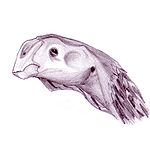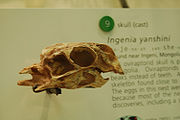
Khaan
Encyclopedia
Khaan was an oviraptorid
dinosaur
that was found in the Djadochta Formation
of Mongolia
and lived in the Late Cretaceous
Period (Campanian
), 75 million years ago.

 The type species
The type species
Khaan mckennai was in 2001 named by James M. Clark e.a. The genus name is derived from Mongol khaan, "lord" or "ruler". The specific name honours the paleontologist Malcolm Carnegie McKenna.
The holotype
IGM 100/1127, consists of an almost complete skeleton found together with another specimen, IGM 100/1002. Together they were informally referred to as "Romeo and Juliet". These individuals are about four feet long. A third, considerably larger, specimen, IGM 100/973, was referred to the species.
Khaan did not differ much from other oviraptorids. At first, its remains were assigned to "Ingenia
", but the Khaan manual structure, lacking the expansion of the upper third metacarpal, was considered to differ sufficiently from that of "Ingenia" for it to be assigned to its own genus.
Khaan was by Clark assigned to the Oviraptoridae
. Among oviraptorids, it was probably more closely related to Conchoraptor
.
The oviraptorid diet is disputed, with eggs, plants and molluscs having been suggested. Like other oviraptorids, Khaan was probably at least partially a meat eater, feeding on small vertebrate
s like mammal
s, lizard
s and possibly other small dinosaurs. It was also probably feathered.
Oviraptoridae
Oviraptoridae is a group of bird-like, herbivorous and omnivorous maniraptoran dinosaurs. Oviraptorids are characterized by their toothless, parrot-like beaks and, in some cases, elaborate crests. They were generally small, measuring between one and two metres long in most cases, though some...
dinosaur
Dinosaur
Dinosaurs are a diverse group of animals of the clade and superorder Dinosauria. They were the dominant terrestrial vertebrates for over 160 million years, from the late Triassic period until the end of the Cretaceous , when the Cretaceous–Paleogene extinction event led to the extinction of...
that was found in the Djadochta Formation
Djadochta Formation
The Djadochta Formation is situated in central Asia and dates from the Late Cretaceous Period. Laid down in the early Campanian, possibly starting in the latest Santonian, it is dated somewhat uncertainly at about 84-75 mya...
of Mongolia
Mongolia
Mongolia is a landlocked country in East and Central Asia. It is bordered by Russia to the north and China to the south, east and west. Although Mongolia does not share a border with Kazakhstan, its western-most point is only from Kazakhstan's eastern tip. Ulan Bator, the capital and largest...
and lived in the Late Cretaceous
Cretaceous
The Cretaceous , derived from the Latin "creta" , usually abbreviated K for its German translation Kreide , is a geologic period and system from circa to million years ago. In the geologic timescale, the Cretaceous follows the Jurassic period and is followed by the Paleogene period of the...
Period (Campanian
Campanian
The Campanian is, in the ICS' geologic timescale, the fifth of six ages of the Late Cretaceous epoch . The Campanian spans the time from 83.5 ± 0.7 Ma to 70.6 ± 0.6 Ma ...
), 75 million years ago.


Type species
In biological nomenclature, a type species is both a concept and a practical system which is used in the classification and nomenclature of animals and plants. The value of a "type species" lies in the fact that it makes clear what is meant by a particular genus name. A type species is the species...
Khaan mckennai was in 2001 named by James M. Clark e.a. The genus name is derived from Mongol khaan, "lord" or "ruler". The specific name honours the paleontologist Malcolm Carnegie McKenna.
The holotype
Holotype
A holotype is a single physical example of an organism, known to have been used when the species was formally described. It is either the single such physical example or one of several such, but explicitly designated as the holotype...
IGM 100/1127, consists of an almost complete skeleton found together with another specimen, IGM 100/1002. Together they were informally referred to as "Romeo and Juliet". These individuals are about four feet long. A third, considerably larger, specimen, IGM 100/973, was referred to the species.
Khaan did not differ much from other oviraptorids. At first, its remains were assigned to "Ingenia
Ingenia
"Ingenia" is a genus of oviraptorid theropod dinosaurs, with one known species, "Ingenia" yanshini. Fossils have been found in several Late Cretaceous-age formations of Mongolia, most prominently in the Bugin Tsav beds of the Nemegt Formation, which has also yielded the holotype of Mononykus...
", but the Khaan manual structure, lacking the expansion of the upper third metacarpal, was considered to differ sufficiently from that of "Ingenia" for it to be assigned to its own genus.
Khaan was by Clark assigned to the Oviraptoridae
Oviraptoridae
Oviraptoridae is a group of bird-like, herbivorous and omnivorous maniraptoran dinosaurs. Oviraptorids are characterized by their toothless, parrot-like beaks and, in some cases, elaborate crests. They were generally small, measuring between one and two metres long in most cases, though some...
. Among oviraptorids, it was probably more closely related to Conchoraptor
Conchoraptor
Conchoraptor is a genus of oviraptorid dinosaur from the late Cretaceous Period of what is now Asia.-Description:...
.
The oviraptorid diet is disputed, with eggs, plants and molluscs having been suggested. Like other oviraptorids, Khaan was probably at least partially a meat eater, feeding on small vertebrate
Vertebrate
Vertebrates are animals that are members of the subphylum Vertebrata . Vertebrates are the largest group of chordates, with currently about 58,000 species described. Vertebrates include the jawless fishes, bony fishes, sharks and rays, amphibians, reptiles, mammals, and birds...
s like mammal
Mammal
Mammals are members of a class of air-breathing vertebrate animals characterised by the possession of endothermy, hair, three middle ear bones, and mammary glands functional in mothers with young...
s, lizard
Lizard
Lizards are a widespread group of squamate reptiles, with nearly 3800 species, ranging across all continents except Antarctica as well as most oceanic island chains...
s and possibly other small dinosaurs. It was also probably feathered.

